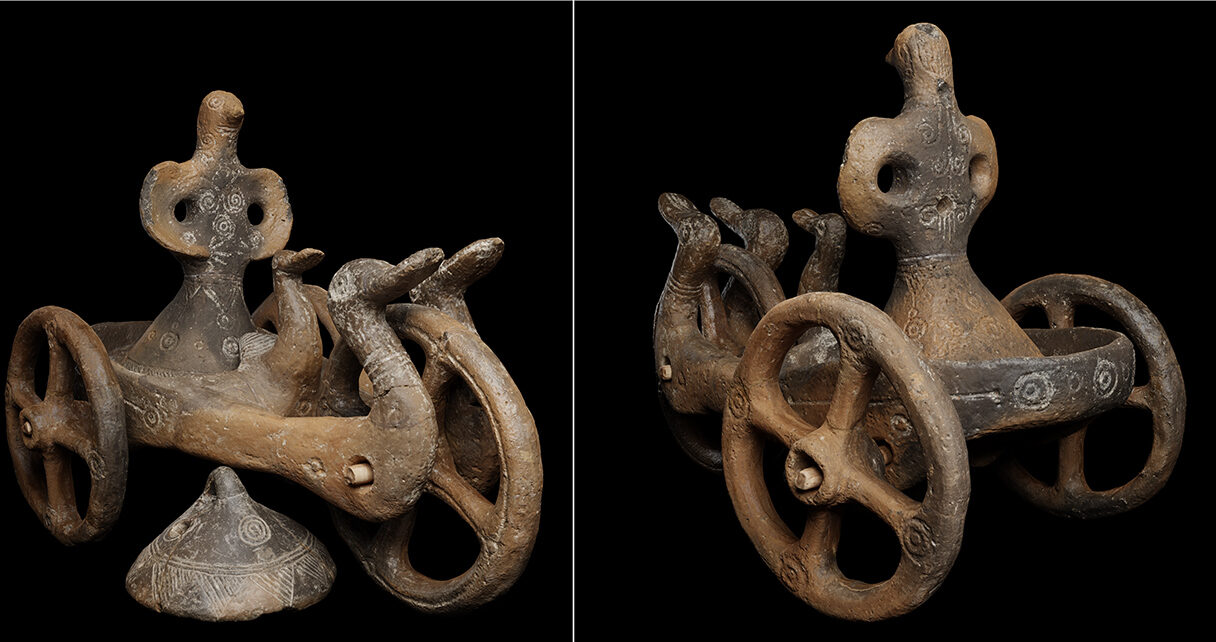
No one was sure how the structures were tied to cultural developments elsewhere in Europe, although scattered finds of bronze artifacts showed the enclosures weren't completely isolated. "They were seen as unicorns on the landscape," says Barry Molloy, an archaeologist at University College Dublin. "This was thought of as a backwater."
In 2015, Molloy and other archaeologists turned to satellite imagery to see whether they could spot more structures that ground-based investigations had missed. Last week in PLOS ONE, they report finding more than 100 of these distinct enclosures in what is today Serbia. Spaced closely together, they form a belt stretching 150 kilometers along the Tisza River, a major north-south artery dividing the Pannonian Plain. The findings suggest the structures were part of a vast network of settlements that took part in a booming, continentwide bronze trade that flowered some 3600 years ago.
"For the first time we can see the extent of this phenomenon," says Austrian Archaeological Institute archaeologist Mario Gavranovic, who was not part of the new study. "The remote sensing approach is great."
The structures, many identified for the first time, have been hiding in plain sight. Many are invisible from the ground because they were plowed nearly flat after decades of intensive agriculture or destroyed in prehistoric times. After identifying the enclosures in Google Earth photos, Molloy and his team flew over the area in a small airplane, then visited as many of the sites as possible by foot. "We spent a lot of time trudging through mud," Molloy says.

The authors argue the walls and ditches protected small settlements, and they say concentrations of artifacts and household refuse suggest each enclosure was home to a handful of extended families. But what those habitations looked like — or whether they were occupied year-round — remains unclear. "It's a new story that changes our knowledge of the late Bronze Age and the Balkans," says co-author Dragan Jovanović, an archaeologist at the City Museum of Vršac. "It's pretty amazing it remained hidden until now."
Why they needed defensive earthworks remains unclear. Clay chariots and bronze weaponry found in cemeteries near some enclosures suggest the inhabitants were familiar with warfare. But most of the newly discovered enclosures are just 5 or 10 kilometers apart, each visible from its closest neighbors. They all shared similar pottery styles and architecture. It's unlikely the people living here were enemies or competitors, Molloy argues: "The fact that they're sharing the landscape means they're cooperating."
The settlements were also linked to a wider world through the trade in bronze and other materials, the team suggests, part of a continental flourishing in trade and connectivity prompted by new metallurgical techniques. The 3 centuries after 1600 B.C.E. also marked the heyday of such civilizations as the Mycenaeans in Greece, the Hittites and Babylonians in the Near East, and Egypt's New Kingdom.
"The world changed around 1600 [B.C.E.]," says University College London archaeologist Miljana Radivojević, who was not part of the new research. "We see a huge shift in behavior at the time, and this is neat new evidence to show how that happens in this region."
The new sites add to others found recently in Hungary and Romania to form what the authors call the lower Pannonian network. Instead of the densely packed, walled cities favored in Egypt, the Near East, and Greece, the people of the Pannonian Plain left themselves lots of elbow room: One enclosure, excavated over the past 20 years in Romania, featured more than 33 kilometers of ramparts and ditches enclosing an area of more than 17 square kilometers. "These people were aware of urban civilizations in the Mediterranean," Molloy says, "but didn't emulate that style of living."
However, that doesn't mean Pannonian Plain society was any less intricate. "These sites are big in a horizontal sense," Radivojević says. "It's their connectedness we should be using to judge how complex they were."
Other experts say lots of questions remain. So far, there's little evidence for houses or permanent structures within the enclosures, for example, although Molloy hopes they might find evidence of these in the future. It's possible the rings were seasonal gathering places, ceremonial centers, or even cattle pens — or something else entirely. "Their interpretation is still on the level of a model, not accepted truth," says University of Belgrade archaeologist Marija Ljuština, who was not involved with the research. "I'm keeping my fingers crossed more research will bring confirmation."
By 1200 B.C.E., something had gone wrong. The enclosures were abandoned. Test trenches showed that some of the sites were not just vacated, but deliberately dismantled — their ditches filled, their walls toppled. The reason remains a mystery, but it echoes similar societal collapses from Egypt to northern Germany around the same time.
The sheer size of the enclosures means they may remain enigmatic for years to come. But they're helping fill in a blank spot on the map of Bronze Age Europe. "They've opened up a whole new avenue for excavation and research," Radivojević says. "These dots weren't connected before, which makes this research valuable."



Reader Comments